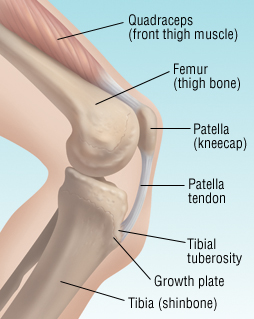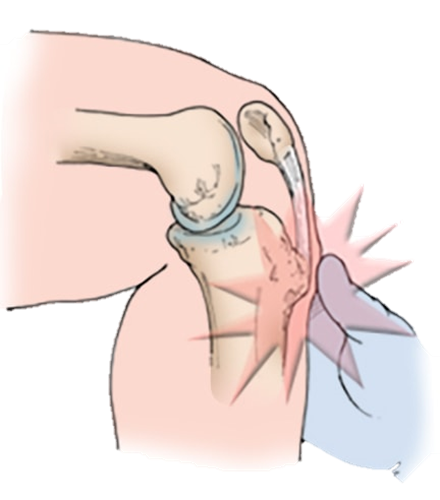Osgood Schlatter disease or Osgood Schlatter lesion is a very common cause of knee pain in children between the ages of 10 and 15 years old. Knee pain which is localised to a specific point on the front of your shin bone, just below your knee. This bony protrusion is called the tibial tuberosity.
Symptoms
Pain becomes worse with exercise, particularly weight-bearing exercise such as running, football, and sports involving jumping. You will likely have pain when contracting (tensing) the quadriceps muscles with your leg straight. Squatting is also likely to be painful, particularly a single leg squat.
Causes
Osgood Schlatter syndrome is primarily an overuse injury although certain factors can increase the likelihood of sustaining this condition.
Age
It is more likely to affect boys aged around 13 to 15 years old than girls. However, girls can be affected. If they are though, it is more likely to occur earlier, at about aged 10 to 12 years old. Obviously, this is a general guide and ages can vary. It occurs due to a period of rapid growth, combined with a high level of sporting activity. Osgood Schlatter can occur in adults, however, it is rare. It is more likely if it was not been treated properly during your teenage years.
Activity Levels
Children who do lots of weight-bearing sports, running, jumping and football are most at risk. Managing training loads and symptoms is important.
Foot Biomechanics
Overpronation is where the foot rolls in or flattens too much when you walk or run. This, in turn, causes the lower leg to rotate in and as a result, the knee. This twisting increases the forces through the patella tendon.
Anatomy
As the young athlete’s bones grow quickly, it can take some time for the muscles and tendons to catch up. If the muscles have not yet adapted to the length of the bones, this can result in additional strain. The additional strain pulls at point the tendon inserts into the bone. This is frequent in younger athletes because their bones are still soft and are not yet fully grown.

The patella tendon connects the bottom of the kneecap to the shin bone. It attaches at a bony protrusion called the tibial tuberosity.
Osgood Schlatters Disease is a painful reaction at this point. Over time it becomes progressively worse as tendon pulls at the growth plate at the top of the tibia.
With repeated trauma, new bone grows back as part of the healing process. This causes an obvious prominent bony lump felt at the tibial tuberosity.
Treatment
Treatment for Osgood Schlatter’s disease consists of reducing pain and inflammation, along with longer-term management of training. Education is important, not just for the young athlete but also for parents as well.
- Cold Therapy
- Rest
- Patella Tendon Strap
- Patella Tendon Taping
- Medication
- Thigh massage
Gentle stretching exercises, particularly for the quadriceps muscles can be done as soon as pain allows. If the bones of the young athlete have grown quickly during a growth spurt and the thigh muscles have not yet caught up then lengthening them through stretching exercises can help reduce the strain on tendon insertion into the bone.
Contact Me
Let's chat!
Need more information? Send me an email or drop me a line. I don’t bite!
- Charlotte@rehabontheroad.co.uk
- 07971448719

